When we originally reviewed AMD’s latest Ryzen 8000G APUs (Ryzen 7 8700G and Ryzen 5 8600G) last month, we became aware of an issue that caused the APUs to freeze after just a few minutes. This creates a problem for several reasons, firstly it compromises our data to reflect the true capabilities of the processor, and secondly, it highlights the issue of AMD forgetting to disable it from its mobile line of Pheonix chips (Ryzen 7040) When implemented to the desktop.
We’ve updated the data in our Ryzen 7 8700G and Ryzen 5 8600G reviews to reflect performance with STAPM on the original firmware and with STAPM removed in the latest firmware. Click the link below to access our updated full review:
As we highlighted in our Ryzen 8000G APU STAPM limitations article, AMD implemented updated firmware through AM5 motherboard vendors such as Asus that removed the STAPM limitations. To quickly review the Skin Temperature Aware Power Management (STAPM) feature and its purpose, AMD introduced this feature in 2014. STAPM itself is a feature implemented in its mobile processor. It is designed to extend on-chip power management by taking into account the internal temperature of the processor and the surface temperature of the laptop (i.e. skin temperature) picked up by the on-chip thermal diodes.
The purpose of STAPM is to prevent laptops from getting too hot and uncomfortable for the user, allowing the processor to proactively suppress heat generation based on thermal parameters between the chassis and the processor itself. The fundamental problem with STAPM for Ryzen 8000G APUs, including the Ryzen 7 8700G and Ryzen 5 8600G, is that these mobile processors are packaged into a format for use with the AM5 desktop platform. Since the desktop platform is built into the chassis rather than resting on the user’s lap, STAPM functionality becomes irrelevant.
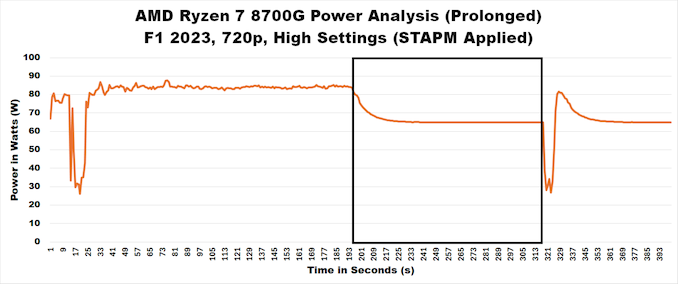
As we can see, when we ran a long gaming load on the Ryzen 7 8700G using the firmware available at launch, we encountered power throttling (STAPM) after about 3 minutes. As can be seen from the figure above, the power dropped from a continuous value of 83-84 W to about 65 W, which is a power drop of about 22%. While we know Zen 4 is a very efficient architecture at lower power consumption, overall performance degrades once this limit is reached. Unfortunately, AMD forgot to remove the STAPM restriction when transitioning Pheonix to the AM5 platform.
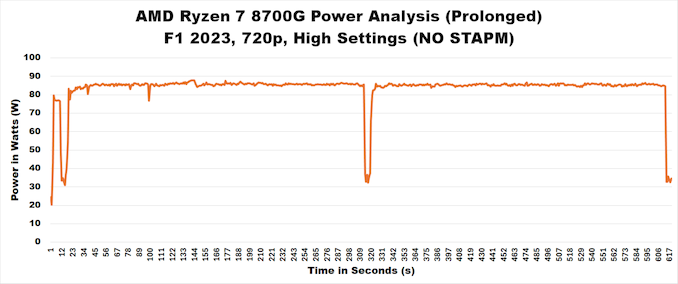
Retesting the same game (F1 2023) at the same settings (720p high), the firmware highlight STAPM has been removed and we can see that we are not encountering any of the power limitations we initially saw. We can see that the power lasts longer than 10 minutes of testing (we tested twice that), and we see no package power drops, at least not anything related to STAPM. This means that for users using the latest firmware on any AM5 motherboard, power and ultimate performance remain consistent with what they should have been when the Ryzen 7 8700G launched.
The key question is, will removing STAPM affect the preliminary results of our Ryzen 7 8700G and Ryzen 5 8600G reviews? If so, how many, or whether there are any? We’ve added new data to our review of the Ryzen 7 8700G and Ryzen 5 8600G, but kept the original results so users can see if there’s a difference in performance. Ultimately, benchmark runs are limited to the time it takes to run them, but in real-world scenarios, tasks like video rendering and longer sustained loads are more likely to show performance improvements. After all, a 22% battery drop is quite significant, especially on a task that might take an hour.
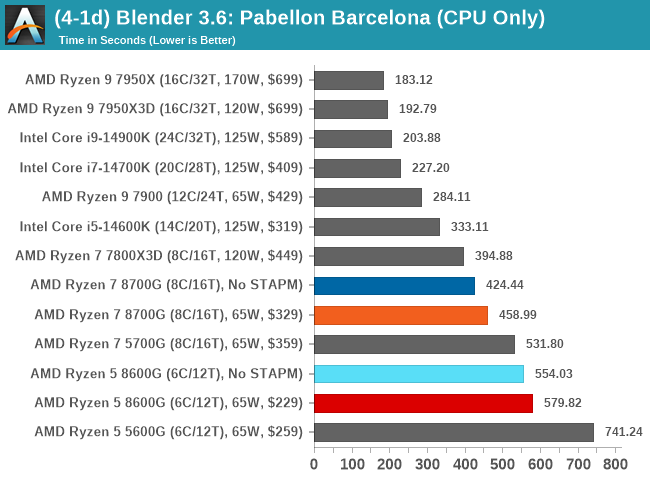
Using one of our longer benchmarks (e.g. Blender 3.6) to highlight where performance gains are significant when using the latest firmware that removes the STAPM limit, we found that the Ryzen 7 8700G’s performance improved after the STAPM limit was removed about 7.5%. In the same benchmark, we saw about a 4% performance improvement on the Ryzen 5 8600G APU.
Across all Blender 3.6 tests in the rendering section of our CPU Performance Suite, the Ryzen 5 8600G’s performance gains hovered between 2% and 4.4%, and the Ryzen 8700G’s performance gains hovered between 5% and 7.5%, which isn’t really true. Free performance, this is the performance that should be available at launch.
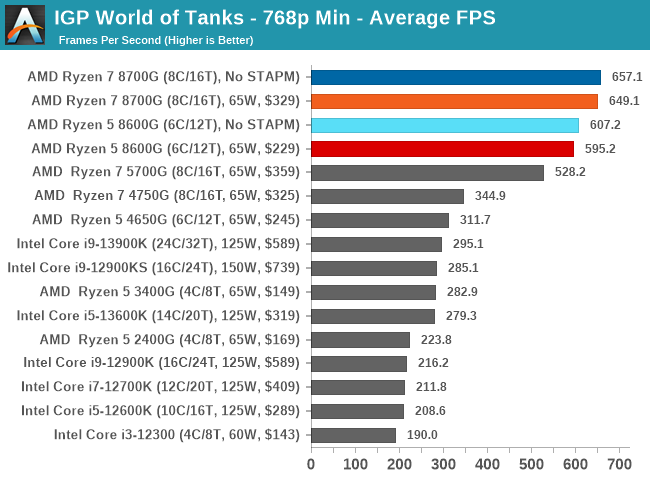
Looking at how STAPM affects our initial data, we can see that the difference in World of Tanks at lowest settings at 768p is only at best about a 1% marginal effect via STAPM. Considering how CPU-intensive World of Tanks is, and combining that with integrated graphics, the AMD Ryzen APUs (5000G and 8000G) both perform well in the game compared to Intel integrated UHD graphics. Given that gaming benchmarks are typically time-limited runs, it’s difficult to determine performance gains. The key takeaway here is that performance should not degrade over a sustained period of time as the STAPM restriction is removed, so our data above and the updated audit data will not be affected.
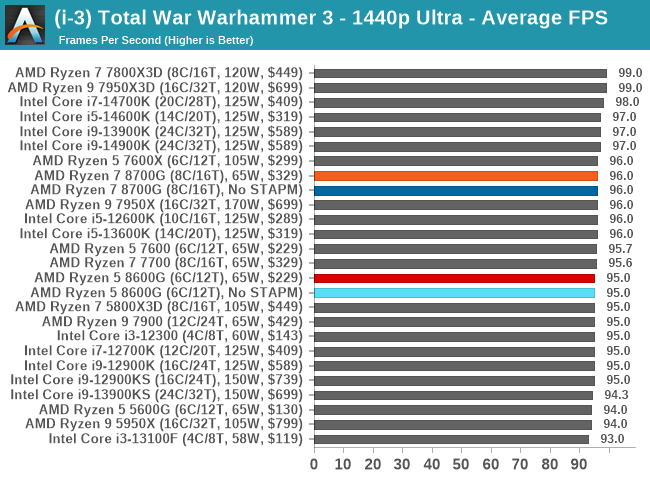
For games using discrete graphics, we didn’t see a significant change in performance, as highlighted by Total War Warhammer 3 in the 1440p Ultra benchmark. Overall, we only saw a small difference in performance (less than 1%) in the discrete graphics results for the Ryzen 7 8700G and Ryzen 5 8600G. As we mentioned, removing the STAPM limit does not necessarily improve performance. Still, it allows the APU to continue to perform at the same level, which is exactly what it was supposed to be when it was released. As with the initial firmware at launch on AM5 motherboards, power consumption will drop by approximately 22% after applying STAPM, limiting full performance over long periods of time.
As we mentioned, we’ve updated our full review of the AMD Ryzen 7 8700G and Ryzen 5 8600G APUs to reflect the latest data we’ve collected in our testing with the latest firmware. Nonetheless, we can fully confirm that the STAPM issue has been resolved and both chips are performing as well as they should.
You can access all the updated data from our reviews of the Ryzen 7 8700G and Ryzen 5 8600G by clicking the links below.